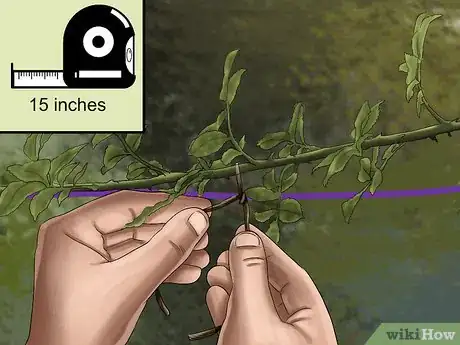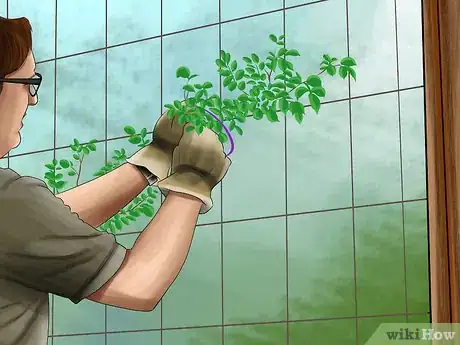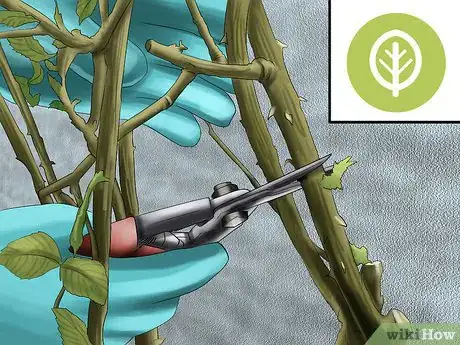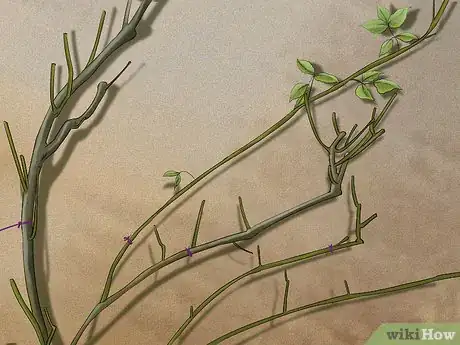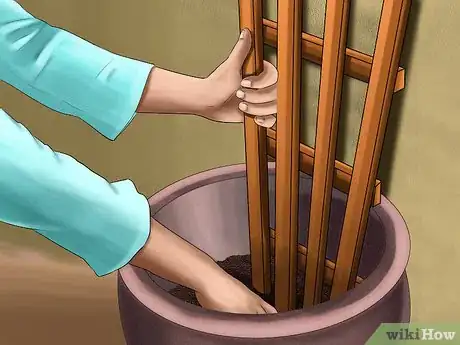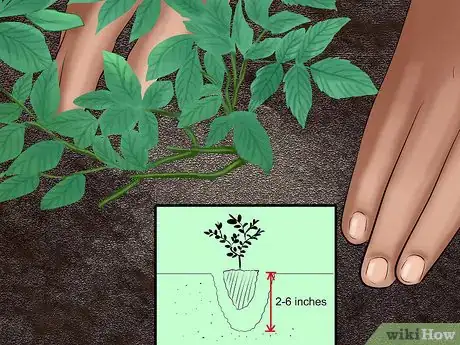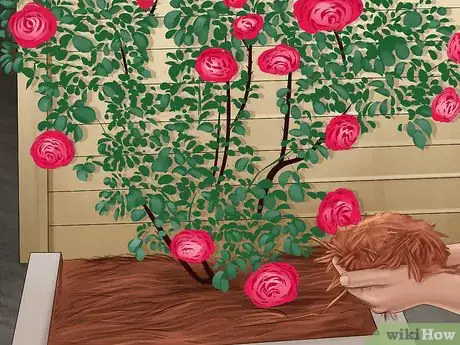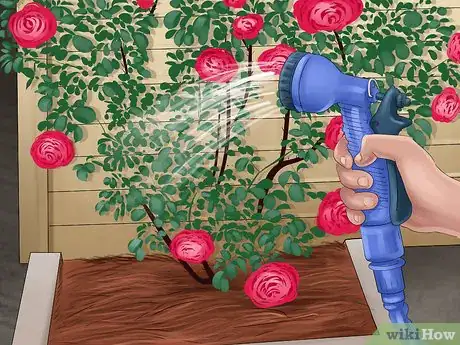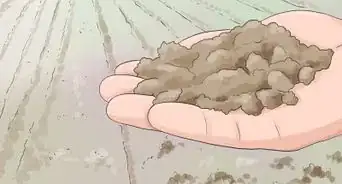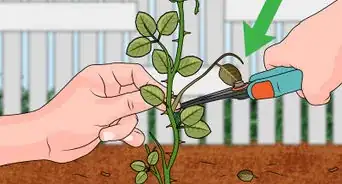This article was co-authored by Maggie Moran. Maggie Moran is a Professional Gardener in Pennsylvania.
This article has been viewed 119,891 times.
Climbing roses come in all sizes, ranging from 1 to 2 feet (0.30 to 0.61 m) tall to 15 to 20 feet (4.6 to 6.1 m) or more. All of these roses need to be trained to climb, however, as they do not climb naturally. In order to train your roses, you’ll need to tie the canes to a support and keep up with pruning. If you haven’t installed a support or planted your roses yet, it’s critical to choose the right location and position them correctly.
Steps
Training Your Roses onto Their Support
-
1Tie the canes to the support without training the first year. When your rose plant starts to grow canes, or stems, long enough to reach your support, tie each of them to it with 8–12 in (20–30 cm) strips of a stretchy material, such as pantyhose. Hold each cane against the support naturally and make loose ties with 4–6 inches (10–15 cm) of “give” so that the plant has enough airflow to grow properly.[1]
-
2Continue tying the canes every 15 inches (38 cm) during the first year. After tying each cane to your support, tend to the plant as is until it grows another 15 inches (38 cm). Once you think the canes have grown about this far from the initial ties, measure the growth with measuring tape to be sure. Then, tie each cane as you did before, loosely to the support without forcing them in any specific direction.[2]
- Continue tying the canes each time they've grown 15 inches (38 cm) past their most recent tie.
Advertisement -
3Train the canes to grow horizontally during the second year. After your rose plant has had at least 1 year to establish itself and begin to grow naturally over the support, select the 4 or 5 most healthy, strong canes on the plant. Use 8–12 in (20–30 cm) strips of pantyhose to loosely tie these healthiest canes to the support, but this time tie them so that they’re positioned as horizontally as possible across the support.
- As they grow, continue tying the canes horizontally at evenly spaced intervals.
- Positioning climbing roses horizontally encourages the growth of side shoots, or laterals, that extend from the main canes. This allows the plant to produce more flowers.[3]
-
4Prune your roses each spring. Once your rose plant is about 3 years old, you’ll need to start pruning off old canes to promote growth. Each spring, after the first main flush of blooms, remove the ties on the old, gray, woody-looking canes and cut them off at the base with pruning shears. This is healthy for your plant because it helps to improve airflow and direct future growth.[4]
- In addition to removing dead, damaged, and diseased canes, you may also need to remove canes that cross and suckers that grow from below the graft union.[5]
- Don’t prune your plant at all during its first 3 years of life.
-
5Train the remaining healthy canes. After removing all of the unhealthy canes, you should ideally have about 3 or 4 of the healthiest canes left. Once you’ve done this annual pruning, tie the remaining canes to the support loosely with strips of pantyhose. As the canes grow, continue tying them to the support horizontally at evenly spaced intervals.[6]
Installing a New Support and Rose Plan
-
1Decide on a location that’s sunny, sheltered, and has good drainage. Roses grow best when they’re exposed to 6 hours of sun daily and are protected from harsh elements, such as wind. They also need to be planted in soil that drains well, or else rotting may occur. Choose a location in your yard to install your support that meets these needs.[7]
-
2Select a support. Choose a trellis or other similar structure that your roses can climb on. The support must be large enough and sturdy enough to hold the climbing rose in wet and windy conditions at its mature height. Choose a support that encourages horizontal growth, such as a fence, over a support that allows vertical growth, such as a rose tower. Also, consider ease of access for pruning.[8]
- A smaller climbing rose will do fine with a support that’s 2–5 feet (0.61–1.52 m) tall.
- A larger climber will require a large arbor, pergola, or other sturdy structure.
- Once a climbing rose is established, you won't be able to replace the support without severely damaging the plant. Try to purchase or build a support that will last for several decades.
-
3Install your support. Once you’ve decided on a support and a location, it’s important that you secure your support to the ground. Anchor the base of the support with stakes to enhance its stability. If you’re leaning your support against a wall, be sure to place the base at least 1–2 feet (0.30–0.61 m) away from the wall to allow proper airflow, and so that you’ll be able to access the plant when doing necessary maintenance.[9]
-
4Dig a hole that’s 2 feet (0.61 m) deep. Use measuring tape to measure 18–30 inches (46–76 cm) away from the base of your support. Use a shovel to dig a hole that’s 2 feet (0.61 m) deep and twice as wide as the plant’s root spread. This is where you’ll plant your roses.[10]
-
5Position the graft union below the soil line in cold climates. If you’re planting in an area that has a cold winter climate, put the plant in the hole and position the graft union of the plant, or the bulge where the top and bottom of the plant meet, about 2–6 inches (5.1–15.2 cm) below the soil level. Then, fill in the rest of the hole with soil. This should help to protect the plant from frost.[11]
-
6Place the graft union above the soil line in warm climates. If you’re planting in an area that has a warmer climate, there’s little risk of frost damage. Because of this, you can plant your rose plant with the bulging graft union slightly exposed. Fill your hole with some soil and place the plant in the hole so that the graft union is positioned just above the soil level.[12]
-
7Add mulch to the surface. Spread wood chips or cocoa bean hulls around the base of the rose plant, but be careful not to heap the mulch around the plant’s trunk.[13] This should help the plant to retain water and also protect it from weeds.
-
8Water the root zone heavily twice a week. Roses respond much better to less frequent soakings than frequent sprinklings. Soak the soil around the base of your rose plant with water at least twice a week during the warm summer months and at most twice a week during the rest of the year.[14]
- While roses love water, they may die if they sit in it. Remember that good drainage is crucial for growth.
-
9Wrap your support in burlap during the winter. Your roses will be at risk throughout the winter if you don’t do anything to protect them from the cold weather. To ensure that your roses have the best chance at staying alive and healthy, wrap the plant and the support in burlap and stuff the inside with straw.[15]
Expert Q&A
Did you know you can get premium answers for this article?
Unlock premium answers by supporting wikiHow
-
QuestionWhat is a rambling rose?
 Maggie MoranMaggie Moran is a Professional Gardener in Pennsylvania.
Maggie MoranMaggie Moran is a Professional Gardener in Pennsylvania.
Home & Garden Specialist
-
QuestionHow do you prune a climbing rose bush?
 Maggie MoranMaggie Moran is a Professional Gardener in Pennsylvania.
Maggie MoranMaggie Moran is a Professional Gardener in Pennsylvania.
Home & Garden Specialist
-
QuestionDo climbing roses need to be pruned?
 Maggie MoranMaggie Moran is a Professional Gardener in Pennsylvania.
Maggie MoranMaggie Moran is a Professional Gardener in Pennsylvania.
Home & Garden Specialist
Things You'll Need
- Support
- Pantyhose strips (or other stretchy material)
- Measuring tape
- Pruning shears
- Stakes
- Shovel
- Mulch
- Water
- Burlap
- Straw
References
- ↑ http://www.johnson.k-state.edu/docs/lawn-and-garden/in-house-publications/roses/Climbing%20Roses_Rev%2006-13.pdf
- ↑ http://www.johnson.k-state.edu/docs/lawn-and-garden/in-house-publications/roses/Climbing%20Roses_Rev%2006-13.pdf
- ↑ http://www.johnson.k-state.edu/docs/lawn-and-garden/in-house-publications/roses/Climbing%20Roses_Rev%2006-13.pdf
- ↑ http://www.bhg.com/gardening/plant-dictionary/rose/climbing-rose/
- ↑ http://www.johnson.k-state.edu/docs/lawn-and-garden/in-house-publications/roses/Climbing%20Roses_Rev%2006-13.pdf
- ↑ http://www.johnson.k-state.edu/docs/lawn-and-garden/in-house-publications/roses/Climbing%20Roses_Rev%2006-13.pdf
- ↑ https://www.youtube.com/watch?v=Ff-NESCQQPE&feature=youtu.be&t=22s
- ↑ https://garden.org/learn/articles/view/1281/
- ↑ https://garden.org/learn/articles/view/1281/
- ↑ https://www.youtube.com/watch?v=Ff-NESCQQPE&feature=youtu.be&t=49s
- ↑ https://garden.org/learn/articles/view/1281/
- ↑ https://garden.org/learn/articles/view/1281/
- ↑ https://garden.org/learn/articles/view/1281/
- ↑ https://www.almanac.com/plant/roses
- ↑ http://www.johnson.k-state.edu/docs/lawn-and-garden/in-house-publications/roses/Climbing%20Roses_Rev%2006-13.pdf
About This Article
To train climbing roses during their first year, hold each cane against the support and then loosely attach them to the support using pantyhose or a similar stretchy material. Do this about every 15 inches, but make sure the rose canes are not tied too tightly, which could harm them. The second year, use 8–12 inch strips of pantyhose to loosely tie these healthiest canes so that they are horizontally attached to the support structure. As they grow, continue tying them so that they lie horizontally against the support. For advice from our Horticulturist reviewer on how to prune your roses, read on!

